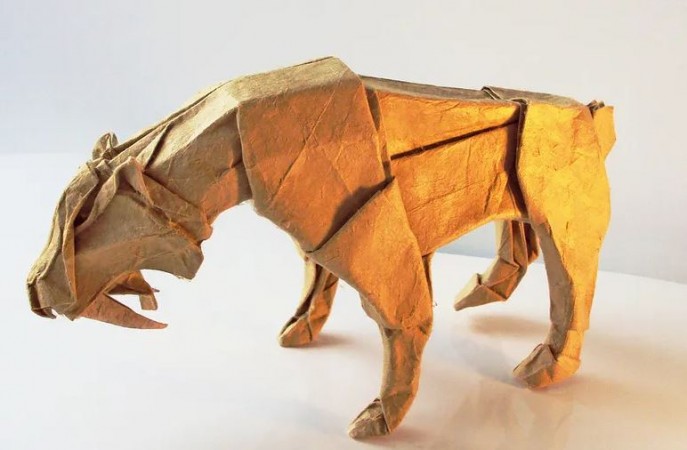
Origami, the traditional Japanese art of paper folding, has captivated people around the world for centuries. It involves transforming a simple sheet of paper into intricate sculptures through a series of precise folds and creases. The art of creating intricate origami sculptures combines creativity, patience, and skill, resulting in awe-inspiring masterpieces. In this article, we will explore the fascinating world of origami and delve into the techniques and intricacies involved in crafting these delicate artworks.
1. Introduction
Origami, derived from the Japanese words "ori" (fold) and "kami" (paper), is a captivating art form that has evolved over centuries. It not only involves folding paper into various shapes but also encompasses the creation of intricate sculptures that can astound onlookers with their beauty and complexity.
2. History of Origami
Origami originated in ancient China around the 2nd century and later found its way to Japan. The Japanese refined the art, elevating it to a form of expression and meditation. Traditional origami designs were often inspired by nature, with animals and plants being popular subjects.
3. Basic Origami Techniques
To begin your journey into the world of origami, it's essential to grasp some basic techniques. These include valley and mountain folds, squash folds, and reverse folds. Understanding these foundational folds will provide you with a strong starting point for more intricate designs.
4. Intermediate Origami Folds
Once you have mastered the basics, you can move on to intermediate origami folds. This stage involves complex maneuvers such as petal folds, sink folds, and pleats. These techniques add depth and dimension to your origami sculptures, allowing you to create more intricate and detailed models.
5. Advanced Origami Models
Advanced origami models push the boundaries of the art form, requiring a high level of skill and precision. These models often involve intricate designs such as insects, dragons, and flowers. Advanced folders may spend hours or even days meticulously folding and shaping the paper to achieve the desired result.
6. Tools and Materials
While origami primarily requires paper, having the right tools and materials can enhance your experience. Special origami paper is available in various sizes, colors, and textures. Additionally, tools like bone folders and tweezers can aid in achieving precise folds and delicate details.
7. Importance of Precision
Precision is a fundamental aspect of origami. Each fold and crease must be executed with care and accuracy. The slightest deviation can alter the final outcome significantly. Attention to detail and patience are key virtues when embarking on an origami project.
8. Benefits of Origami
Engaging in origami offers numerous benefits beyond the creation of beautiful sculptures. It improves hand-eye coordination, concentration, and spatial awareness. Origami also serves as a therapeutic activity, helping to reduce stress and promote mindfulness.
9. Cultural Significance
Origami holds deep cultural significance in Japan. It is often associated with symbolism and represents concepts such as good luck, purity, and tranquility. Origami is also a common feature in celebratory events and festivals, adding a touch of elegance and artistry to the occasion.
10. Origami in Contemporary Art
Origami has transcended traditional boundaries and has found its way into contemporary art. Many artists now incorporate origami techniques into their sculptures, installations, and even fashion designs. The fusion of origami with other artistic mediums has resulted in innovative and visually striking creations.
11. Tips for Beginners
For those new to origami, here are a few tips to help you get started:
Begin with simple models and gradually progress to more complex ones.
Practice folding straight lines and crisp creases.
Follow instructional diagrams or video tutorials to learn specific models.
Experiment with different types of paper to discover the ones you prefer.
Be patient and enjoy the process of folding, even if it takes time to master a particular technique.
12. Common Mistakes to Avoid
Origami can be challenging, especially for beginners. Here are some common mistakes to avoid:
Rushing through the folding process without paying attention to details.
Using unsuitable paper that is too thin or too thick for the desired model.
Neglecting to flatten folds properly, resulting in misshapen sculptures.
Skipping steps or misinterpreting the instructions in diagrams.
13. The Joy of Origami Sculptures
Creating intricate origami sculptures is a fulfilling and rewarding experience. The sense of accomplishment when a complex model comes together is unparalleled. The beauty and elegance of these folded artworks can bring joy to both the creator and those who admire them.
14. Conclusion
Origami is more than just a hobby; it is a remarkable art form that allows individuals to unleash their creativity and express themselves through delicate paper sculptures. With a rich history and a myriad of techniques to explore, origami continues to captivate people worldwide. So pick up a sheet of paper, embrace the art of folding, and let your imagination take flight.
China's Challenge to Western Dominance Faces Hurdles
Justice Srikrishna Raises Alarm Over Data Protection Bill's Govt Exemption, Igniting Privacy Debate
Japan Remembers Shinzo Abe: One Year Later, Pursuing Justice and Honoring a Visionary Leader